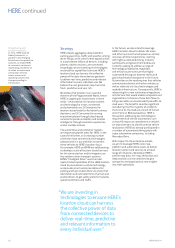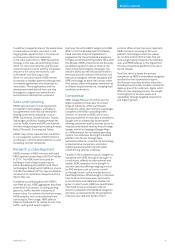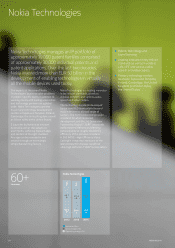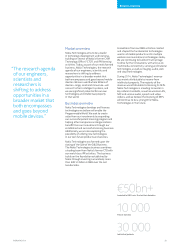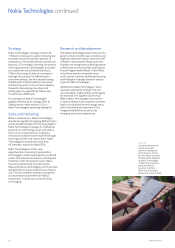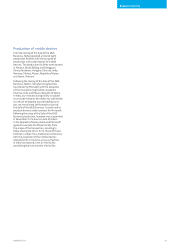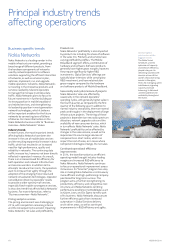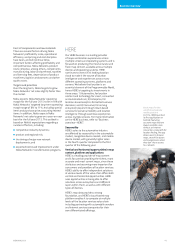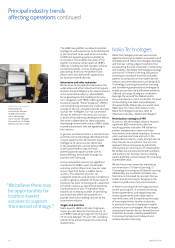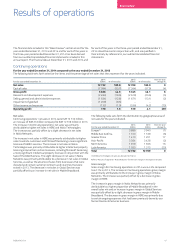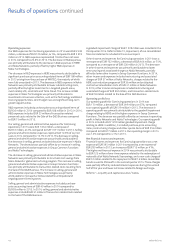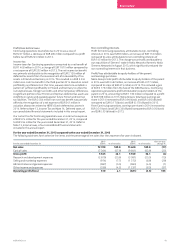Nokia 2014 Annual Report Download - page 42
Download and view the complete annual report
Please find page 42 of the 2014 Nokia annual report below. You can navigate through the pages in the report by either clicking on the pages listed below, or by using the keyword search tool below to find specific information within the annual report.
40 NOKIA IN 2014
Business specic trends
Nokia Networks
Nokia Networks is a leading vendor in the
mobile infrastructure market, providing a
broad range of dierent products, from
the hardware components of networks
used by network operators to software
solutions supporting the ecient interaction
of networks, as well as services to plan,
optimize, implement, run and upgrade
mobile operators’ networks. Nokia Networks
is investing in the innovative products and
services needed by telecom operators
to manage the increase in wireless data
trac. Nokia Networks plans to focus its
future investments in further building on
its strong position in mobile broadband
and related services, and strengthening
its leadership position in next-generation
network technologies, which it believes
will beimportant enablers for the future
networksby connecting tens of billions
of devices. For more information on the
Nokia Networks business refer to “Business
overview—Nokia Networks” above.
Industry trends
In recent years, the most important trends
aecting Nokia Networks have been the
increase in the use of mobile data services
and the resulting exponential increase in data
trac, which has resulted in an increased
need for high performance, quality and
reliability in networks. The continuing data
trac increase has, however, not been directly
reected in operators’ revenue. As a result,
there is an increased need for eciency for
both operators and network infrastructure
and services vendors. In addition to the
attempts to reduce their costs, the operators
want to increase their agility through the
adoption of the emerging Telco Cloud and
network virtualization technologies. Operator
consolidation driven by operators’ needs
to provide a wider spectrum of services,
especially xed-mobile convergence services,
is also a key trend that aects Nokia Networks’
business. For more information, refer to
“Business overview—Nokia Networks”.
Pricing and price erosion
The pricing environment was challenging in
2014, with competition remaining intense
and the consequent price erosion impacting
Nokia Networks’ net sales and protability.
Product mix
Nokia Networks’ protability is also impacted
by product mix including the share of software
in the sales mix. Products and services have
varying protability proles. The Mobile
Broadband segment oers a combination of
hardware and software. Software products
generally have higher gross margins; however,
they require signicantly higher R&D
investments. Global Services’ oerings are
typically labor-intensive, while carrying low
R&D investment, and have relatively low
gross margins compared to the hardware
and software products of Mobile Broadband.
Seasonality and cyclical nature of projects
Nokia Networks’ sales are aected by
seasonality in the network operators’
spending cycles, with generally higher sales in
the fourth quarter, as compared to the rst
quarter of the following year. In addition to
normal industry seasonality, there are normal
peaks and troughs in the deployment of large
infrastructure projects. The timing of these
projects is dependent on new radio spectrum
allocation, network upgrade cycles and the
availability of new consumer devices, which
in turn aects Nokia Networks’ sales. Nokia
Networks’ protability can be aected by
changes in the sales volume, as well as the
requirement to source large volumes of
components on short notice, which can
impact the cost of sales, or in cases where
component shortages emerge, the net sales.
Continued operational eciency
improvements
In 2014, the transformation to an ecient
operating model brought industry leading
margins and increased R&D eciency to
Nokia Networks. Nokia Networks continues
to focus on operational improvement across
its business. Its “Smarter” program has a key
role in making Nokia Networks a continuously
more ecient and high-performing company
positioned for long-term success. The
program aims at further strengthening its
productivity, eciency and competitive cost
structure, and Nokia Networks will bring
performance excellence methodologies such
as Kaizen, Lean, and Six Sigma to every part
of its business. Nokia Networks also pursues
further eciency gains from increased
automation in Global Services delivery
and in other areas, as well as continued
improvements in R&D eciency and agility.
Principal industry trends
aecting operations
Uninterrupted
service even at the
biggest events
The Nokia Smart
Scheduler, used to
optimize cell capacity
and network eciency,
played a key part in
delivering seamless LTE
services atone of the
world’s showcase racing
events inShanghai,
China. Bymanaging uplink
interference, signaling
capacity and load
balancing, it delivered
uninterrupted service
availability throughout
the event.


